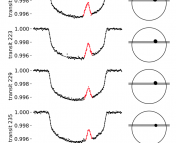Authors: Soumitra Hazra, Ofer Cohen, Igor V. Sokolov
First Author’s Institution: Lowell Center for Space Science and Technology, University of Massachusetts Lowell
Status: Accepted to ApJ (open access)
Earth’s magnetic field protects our ozone layer from the solar wind and cosmic rays, keeping dangerous UV rays from reaching us. In exoplanet theory, magnetic fields may play an important role in determining how a planet evolves and whether it retains an atmosphere. But how can we study the magnetic fields of planets so far away? Today’s paper explores the radio transit method as an indirect way to measure these fields.
Radio Transits
Astronomers have observed natural radio emissions from Jupiter and other solar system planets, produced by their magnetic fields’ interactions with the solar wind, a continuous flow of particles from the Sun. However, this type of signal is generally too weak for current telescopes to detect at interstellar distances.
The majority of known exoplanets today have been discovered with the transit method, which is typically performed in optical frequencies, where stars’ spectra peak (e.g. Kepler & TESS). This method detects planets as they pass in front of their stars, causing periodic dips in the star’s apparent brightness. Today’s paper explores a similar method to study exoplanets at radio frequencies, as their magnetic fields affect the star’s thermal radio emission.
The outermost part of a star is called the corona, and it extends far beyond the photosphere, becoming less dense (and less hot) with increasing distance. This plasma emits radio waves via thermal bremsstrahlung emission, where charged particles in electric fields emit some of their kinetic energy as electromagnetic waves. A very close-in planet (e.g. a hot Jupiter) and its magnetic field can interact with the corona, altering this radio output and perhaps producing an observable signal in radio light curves.
Modeling star-planet interactions
The authors use the BATS-R-US model and the Alfvén Wave Solar Atmosphere Model to study the magnetohydrodynamical (MHD, a long word to describe the behavior of conductive fluids in magnetic and electric fields) interactions between a planet and its host star. The stellar model is based on real observations of HD 189733, the nearest that hosts a transiting hot Jupiter. The model planet (an idealized version of the star’s observed hot Jupiter) is assigned a radius of 0.2Rsun. They test 3 different magnetic field strengths for the planet: no magnetic field, an Earth-like magnetic field (0.3 G), and a higher strength magnetic field (3 G). They simulate each of these 3 planets with two circular orbit radii: 10 and 20 times the radius of the star.
For each of these magnetic field and orbit scenarios, the authors use a ray tracing algorithm to simulate the coronal emission’s path through the ambient medium, undergoing refraction. This allows them to create synthetic radio images at different points throughout the planet’s orbit, which are then turned into simulated light curves. Figure 1 below shows an example of these images.

Figure 1: Radio images from the model at 1 GHz for the 3 G, 10R* orbit case. The middle panel shows the planet in transit, and the side panels show the planet at its furthest apparent separation from the star on either side. (from Figure 1 in the paper)
Coronal Compression
As the radio images in Figure 1 show, the planet warps the coronal material as it moves throughout its orbit, creating a ring of compressed material with higher emission around itself, as well as a tail trailing it in orbit. As this over-density in ambient material passes in front of the star, it refracts radio emission, causing variations in the star’s apparent brightness beyond the standard visual transit dip.
As one moves further from the star, material becomes cooler, and coronal emission peaks at shorter frequencies. Thus, the size of the planet’s orbit impacts what we observe at different frequencies. For the short-orbit case (10R*), the planet passes through hot plasma regions, while the longer-orbit (20R*) planet passes through lower-density outer regions of the corona. Figure 2 below shows the light curves for the magnetized models in both orbits.

Figure 2: Radio light curves for simulated transits. The left panel shows the short-orbit results, and the right shows the longer-orbit results. The solid lines on both panels represent their respective 0.3 G model and the dashed lines, the 3 G model. The line colors correspond to radio frequencies as indicated in the legend. Along the x-axis, phase 0 begins when the planet is behind the star, and the mid-transit point at phase 0.5 is marked in a black dashed line. There’s a lot going on here during and surrounding the transit, but that’s the important result. We see very different light curves for different frequencies and model scenarios, indicating that observing light curves like this from real stars may actually allow researchers to constrain planets’ magnetic field strengths. (from Figures 3 and 6 in the paper)
Measuring Magnetic Fields
Ultimately, the goal of this radio transit method is to translate the radio modulation signal to a planetary magnetic field strength. The authors calculate the “extreme modulation,” or difference between the maximum and minimum flux points in the light curves. This modulation varies based on three factors examined: the planet’s orbital separation, the planet’s magnetic field strength, and the frequency observed.
The results suggest that radio observations across a range of frequencies could reveal information about a transiting planet’s magnetic field and thus its interior. The authors note that the thermal radio emission from stellar coronas is difficult to detect with current technology and only possible for a few nearby stars at this time. While this study focuses on planetary modulations on thermal radio emission from stellar coronae, stars also emit stronger transient radio signals (for example during flares), which should be considered in future studies. Overall, detecting exoplanetary magnetic fields via radio transits is a promising method, and as stronger radio telescopes are constructed (e.g. the Square Kilometer Array), it becomes more feasible.
Edited by Lindsay DeMarchi
Cover image credit: Hazra et al. (2022)




